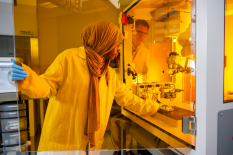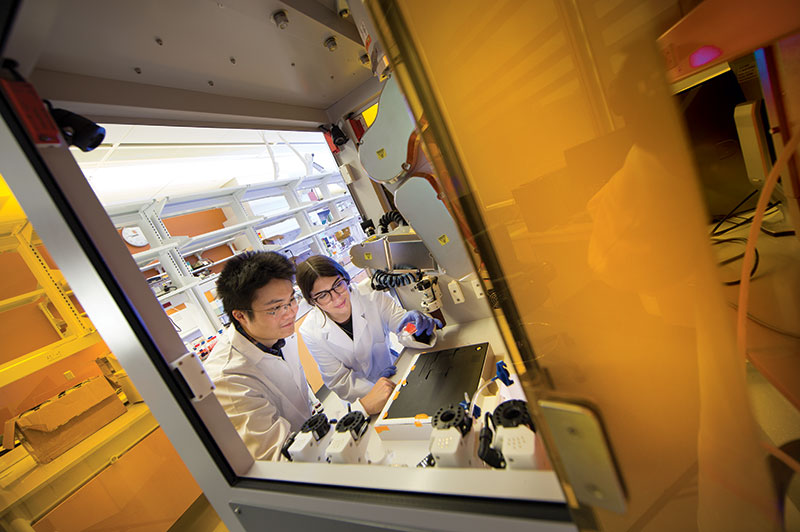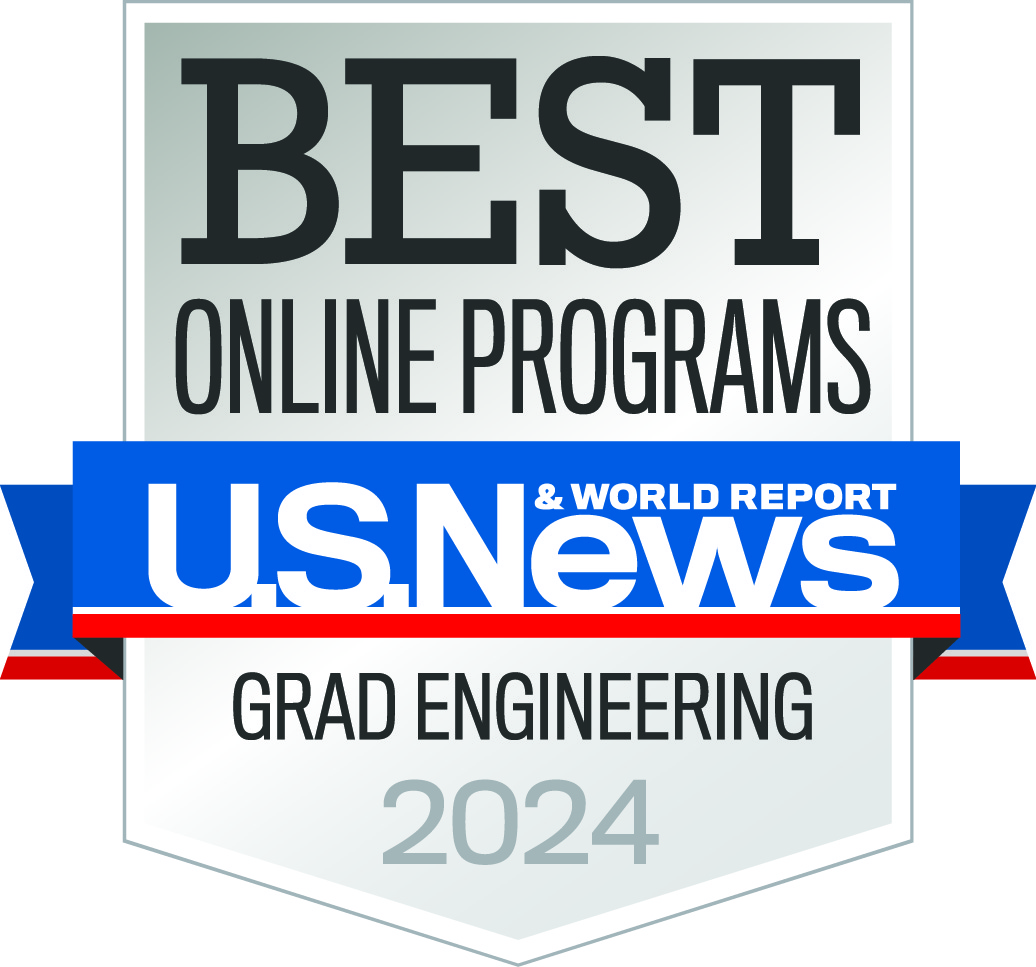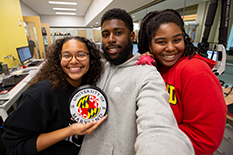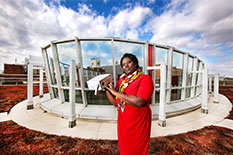News Story
Maryland Engineering Graduate Programs: Top 10 Public, Four Years in a Row

In fall 2021, the A. James Clark School of Engineering’s graduate students returned to full-time in-person learning and research, and the buzz in Maryland Engineering’s classrooms and labs hasn’t subsided since.
Young innovators published results of their breakthrough energy storage studies in Nature Nanotechnology and Nature Communications, brought a 500-year old helicopter design to life “with flying colors,” developed respirator masks for the next pandemic, enhanced the treatment for type 1 diabetes, and led a multimillion-dollar project in autonomy for the U.S. Army. All these achievements and more, combined with faculty excellence, an extensive network of industry and government partners, unique employment opportunities, inclusive culture and vibrant student life, and a home address five miles away from Washington D.C. placed Maryland Engineering among top 10 public graduate schools in the 2023 U.S. News & World Report Best Graduate Schools ranking.
“Through Maryland Engineering programs, innovation abounds,” Dean Samuel Graham, Jr. said. “When you combine world-class people, facilities and partnership in an ecosystem that fosters collaboration and creativity, you’re going to see great innovation - and that’s what we see at the Clark School. We’re excited to have a role in shaping a better future for everyone.”
The A. James Clark School of Engineering maintained its position among the best ten U.S. public educational institutions for the fourth consecutive year. Two of its programs—Computer Engineering and Materials Science & Engineering—climbed three and four steps in their respective rankings. On the overall list, the college ranked #21 among over 200 private and public engineering colleges, sharing this place with Harvard University.
Here are some reasons why.
Building an AI Research Powerhouse
In May 2021, the University of Maryland (UMD), University of Maryland Baltimore County (UMBC), and Army Research Lab (ARL) launched ArtIAMAS (AI and Autonomy for Multi-Agent Systems), a cooperative initiative aimed at developing solutions capable of reducing human workload and risk in complex environments such as battlefield and search-and-rescue operations. With $68M in spending spanning across five years, this program has already united 109 ARL, 64 UMD, and UMBC researchers, as well as 117 graduate students. Together, they are advancing machine learning, artificial intelligence, sensing, autonomy, and cybersecurity to build and deploy technologies from wearable devices to unmanned aircraft, working in cooperation with each other and humans.
“The Army Research Lab is very keen to work with our students not only because of the technical advancements they can come up with, but also because this project supports the lab’s workforce development efforts in the region,” said Professor Derek Paley, the Maryland Robotics Center Director and lead ArtIAMAS researcher.
Proving Da Vinci Right
In a new spin on a classic idea, graduate students from the University of Maryland’s Department of Aerospace Engineering took one of Renaissance master Leonardo da Vinci’s innovative designs, the “Aerial Screw,” and developed a working prototype. Built out of a winning submission to the Vertical Flight Society’s 2020 Student Design competition—where Maryland Engineering students have been successfully competing for more than twenty years—Crimson Spin, a small, unmanned aerial vehicle, flies through the combined lift of four whirring red spiral-shaped blades. The team unveiled their prototype at the Vertical Flight Society’s 2022 Transformative Vertical Flight Conference, proving to remain at the forefront of innovative vertical flight designs and engineering.
Advancing Energy Storage
One of the most prolific energy technology advancement teams in the nation, Professor Chunsheng Wang's group, published yet another set of papers in top research journals. Tao Deng, a Ph.D. student at the Chemical & Biomolecular Engineering Department, served as the first author on a study highlighted in Nature Nanotechnology. This article discussed sodium (Na) batteries, energy storage devices that are safe and attractive alternatives to lithium-ion batteries. Overcoming the challenge posed by dendrite formation, the team developed an yttria-stabilized zirconia (YSZ)-enhanced beta-alumina solid electrolyte (YSZ@BASE) for low-temperature Na-batteries. This electrolyte boated an extremely low interface impedance with the Na metal anode while achieving an extremely high density.
“Our research represents a new class of sodium batteries with a significantly lower operating temperature (80 °C), which translates into a safer solid-state battery than others in the same class,” said Deng. This study marked another milestone in the work UMD innovators do to develop a safer, inexpensive, and long-lasting battery.
In March 2022, Dr. Wang’s graduate student Singyuk Hou published a new study on the development of a cheap, membrane-free chlorine battery in Nature Communications. This innovation will help create an energy storage unit that will advance the use of solar and wind power.
Fighting flooding and inequality
Zeinab Yahyazadeh Jasour, a Ph.D. student at the Department of Civil & Environmental Engineering, is working to help coastal communities, like Dorchester County on Maryland’s Eastern Shore, to prepare and adapt to the realities of climate change.
Mentored by assistant professor and recipient of two National Science Foundation CAREER Awards Allison Reilly, Jasour is assessing the impact on transportation and the movement of goods and people in the county, as residents grapple with roads that flood over at high tide. Her research can help policymakers determine what roads can be raised or buttressed with levees or seawalls, and which cannot be saved over the long-term even with the most ingenious tools engineers can offer. Her work can also help ensure infrastructure built in a more equitable way, without benefiting only affluent county residents at the expense of low-income communities.
Putting food waste to use
In America alone, about 103 million tons of food are discarded annually, with much of it going into landfills, where it rots and emits greenhouse gases. Moreover, as food takes up larger and larger swaths of available landfill, there’s less room for other types of waste.
Maryland Engineers have a solution that reduces environmental threats and provides sustainable energy. Working under the supervision of civil and environmental engineering assistant professor Guangbin Li, master’s student Camila Proano is exploring methods of converting food waste into biogas, which can then supply heat, electricity, and vehicle fuel. The residual solids and liquids left over after digestion are rich in nutrients and organic matter and can be reused as fertilizer. Proano, who is wrapping up her master’s thesis this year, has been awarded a Clark Fellowship that will support her as she moves ahead with her doctorate.
Preparing for the next pandemic
Bioengineering M.Eng. student Quinn Burke is working with the Robert E. Fischell Institute for Biomedical Devices to test face masks and respirators in order to measure their effectiveness in safeguarding against COVID-19 and other health hazards. Burke is a recipient of the institute’s MPowering the State Student Entrepreneurship Fellowship, which supports M.Eng. students working to transition innovative medical device projects into business ideas. Since last summer, Burke has worked with Fischell Institute engineer Kevin Aroom to test dozens of off-the-shelf N95 and KN95 masks on behalf of government and industry consumers to see how well they filter. In addition to mask testing, Burke has spent much of his time working to develop a low-cost respirator testing mechanism. His aim is to support the development of innovative mask designs by providing a cheaper and more easily recreated testing set-up than those that are currently available.
Read the story about this research in the Baltimore Sun.
Improving treatment for type 1 diabetes
Alisa White, a Fischell Department of Bioengineering Ph.D. student, received a two-year National Institutes of Health F31 predoctoral fellowship totaling $65,000. This award will support her research helping patients with type 1 diabetes.
White, who works in Professor Xiaoming (Shawn) He’s lab in collaboration with professor Jonathan Bromberg’s lab in the Department of Surgery, studies potential treatment pathways that could eliminate the need for regular injections. She is zeroing in on what are known as islets of Langerhans–a group of cells in the pancreas which include insulin-producing beta cells. White and He are developing a novel method of encapsulating islets in an engineered core-and-shell structure designed to mimic the pancreas; they believe it will lessen the post-transplantation immune response and minimize or eliminate the need for immunosuppressants. White hopes that the team’s work could one day lead to new treatment options for type 1 diabetes.
Program rankings*
Top 10 programs
Aerospace Engineering: #10 public; #15 overall
Computer Engineering: #10 public; #15 overall
Electrical Engineering: #10 public; #19 overall
Top 15 programs
Biomedical Engineering: #15 public; #32 overall
Materials Science: #13 public; #22 overall
Mechanical Engineering: #11 public; #19 overall
Top 25 programs
Chemical Engineering: #21 public; #34 overall
Civil Engineering: #22 public; #35 overall
*according to the 2023 U.S. News & World Report Best Graduate Schools ranking
Maryland Graduate Engineering in Facts & Numbers
Graduate Student Enrollment: 1,721,
including 24.3% female, 8.5% underrepresented minorities, 10.4% other minorities
Faculty
- 30 National Academy of Engineering members,
- 50+ recipients of the National Science Foundation’s Early CAREER Awards,
- 100+ members of professional engineering societies
Key graduate student employers
- Amazon,
- Northrop Grumman,
- Johns Hopkins University Applied Physics Lab,
- Intel,
- Naval Air Systems Command,
- NASA,
- Meta, and others.
Funding and professional development programs
- Clark Doctoral Fellows Program,
- Future Faculty Program,
- Flagship Fellowship Program,
- President’s Postdoctoral Fellowship Program,
- Dean's Fellowship.
Published March 29, 2022

